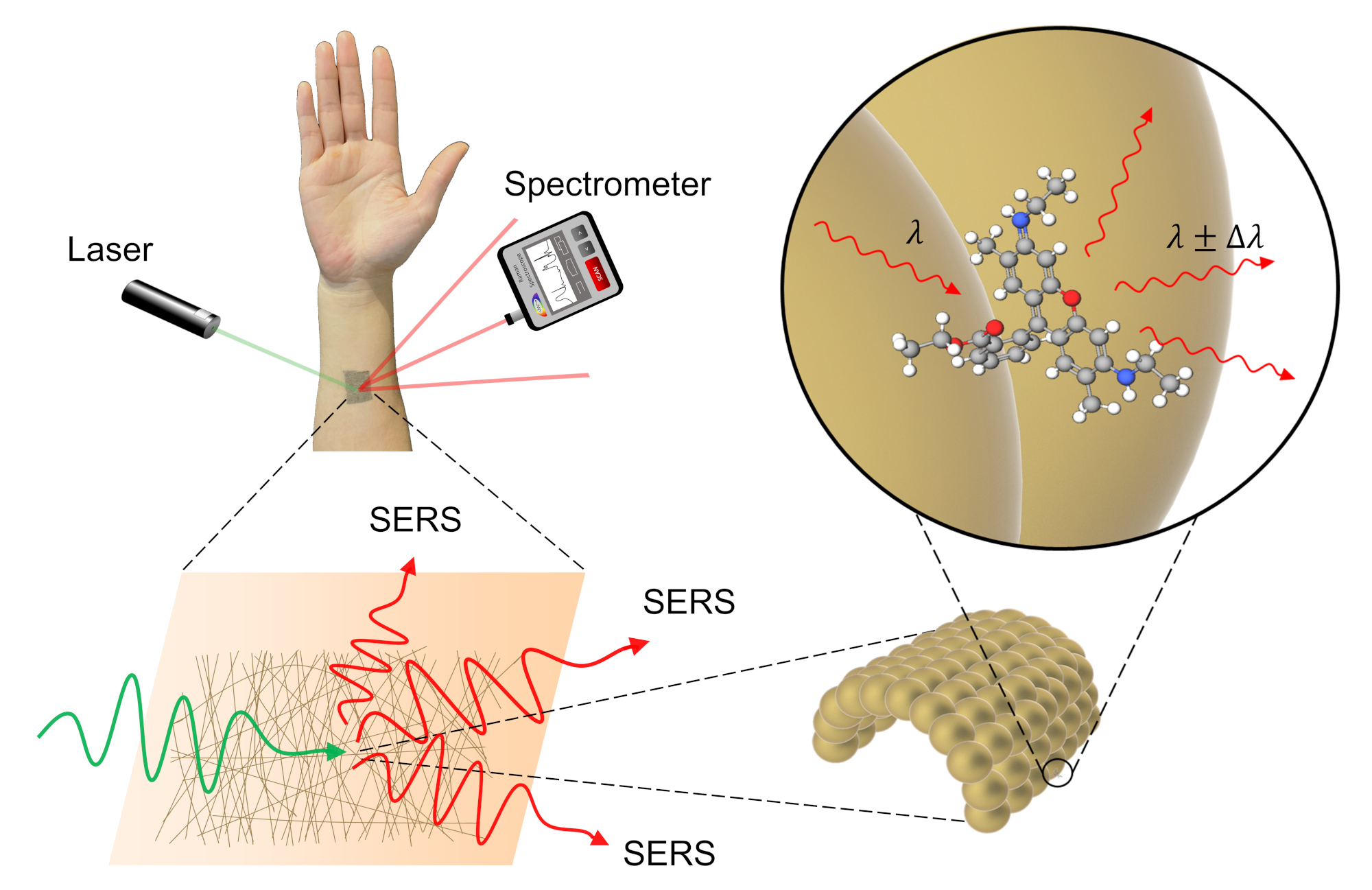Researchers developed a unique, ultra-thin sensor that can be applied to the skin without causing discomfort or irritation. It is made of gold. To conduct on-body chemical analysis, the sensor can monitor several biomarkers or chemicals.
 SERS in action. SERS, or surface enhanced Raman spectroscopy, is a method of detecting the presence of a chemical indirectly by using laser light and a specialized sensor. The gold mesh provides an ideal surface for taking measurements as it does not interfere with the substance being measured. Image Credit: Goda et al.
SERS in action. SERS, or surface enhanced Raman spectroscopy, is a method of detecting the presence of a chemical indirectly by using laser light and a specialized sensor. The gold mesh provides an ideal surface for taking measurements as it does not interfere with the substance being measured. Image Credit: Goda et al.
Through a process known as Raman spectroscopy, the laser light directed at the sensor is modified somewhat based on the molecules that are at that precise point on the skin. The sensor is strong enough for practical usage and can be fine-tuned to be exceedingly sensitive.
Wearable technology is not something unknown or unheard of. It is likely to spot someone with a smartwatch. Several of these can track certain health indicators, such as heart rate, but at the moment they are unable to capture chemical signatures that can help diagnose illnesses.
Additionally, smartwatches or more advanced medical monitoring can be too bulky or often expensive. Due to these shortcomings, a group of scientists from the University of Tokyo’s Department of Chemistry looked for an innovative, non-invasive method of sensing diverse environmental and physiological situations.
A few years ago, I came across a fascinating method for producing robust stretchable electronic components from another research group at the University of Tokyo. These devices are spun from ultrafine threads coated with gold, so can be attached to the skin without issue as gold does not react with or irritate the skin in any way.
Limei Liu, Lecturer, Yangzhou University
Liu added, “As sensors, they were limited to detecting motion however, and we were looking for something that could sense chemical signatures, biomarkers, and drugs. So, we built upon this idea and created a noninvasive sensor that exceeded our expectations and inspired us to explore ways to improve its functionality even further.”
The key part of the sensor is a fine gold mesh since gold has low reactivity, which means that when it comes into contact with something the team wants to assess, like a possible disease biomarker found in sweat, it does not chemically change that object.
But instead, due to the fineness of the gold mesh, it can provide a surprisingly large surface for that biomarker to bind to, and this is where the other components of the sensor come in.
Part of the laser light is absorbed and some are reflected as a low-power laser is directed at the gold mesh. Most of the light that is reflected has the same energy as the light that is coming in.
But, some of the incoming light does lose some energy to the biomarker or another measurable substance, and the discrepancy in energy between reflected and incident light is unique to the substance in question.
This distinct energy fingerprint can be used by a sensor known as a spectrometer to recognize the substance. Raman spectroscopy is the name given to the technique that identifies chemicals.
Currently, our sensors need to be finely tuned to detect specific substances, and we wish to push both the sensitivity and specificity even further in future. With this, we think applications like glucose monitoring, ideal for sufferers of diabetes, or even virus detection, might be possible.
Tinghui Xiao, Research Associate, Graduate School of Science, University of Tokyo
Keisuke Goda, a Professor at the University of Tokyo, stated, “There is also potential for the sensor to work with other methods of chemical analysis besides Raman spectroscopy, such as electrochemical analysis, but all these ideas require a lot more investigation. In any case, I hope this research can lead to a new generation of low-cost biosensors that can revolutionize health monitoring and reduce the financial burden of health care.”
Journal Reference:
Liu, L., et al. (2022) Highly Scalable, Wearable Surface-Enhanced Raman Spectroscopy. Advanced Optical Materials. doi:10.1002/adom.202200054.